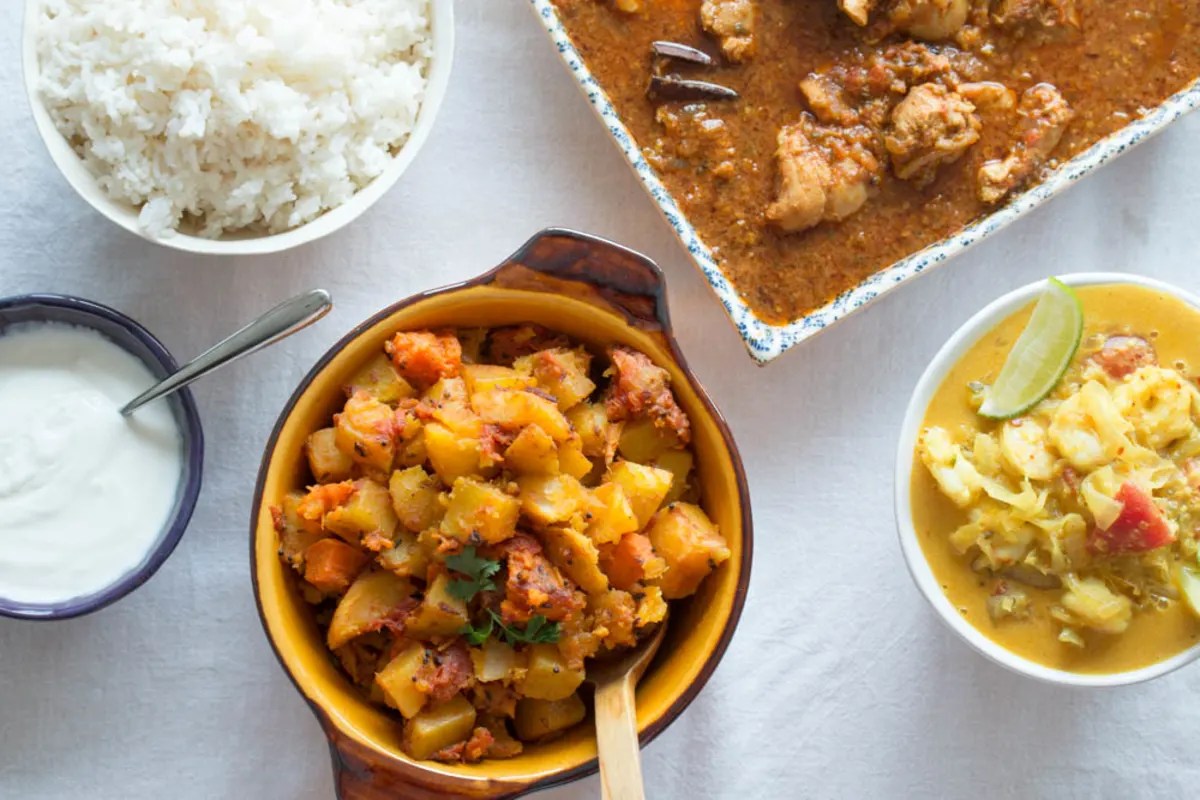Embark on a culinary journey into the vibrant world of Indian cuisine, reimagined for those with nut and allergen sensitivities. This guide unveils the secrets to crafting delicious, authentic curries without compromising on flavor or tradition. We’ll explore substitutions for common allergens, master fundamental techniques, and create a diverse range of flavorful dishes, from mild and creamy to intensely spicy. Prepare to delight your taste buds with a collection of recipes designed for both novice cooks and seasoned chefs seeking allergen-free alternatives.
We’ll delve into the heart of Indian spice blends, uncovering their unique properties and how to adapt them for allergen-free cooking. Learn to create custom spice combinations that perfectly complement your chosen vegetables and proteins. Discover how to achieve the rich, creamy textures of traditional curries using innovative, allergen-free substitutes. This isn’t just about avoiding ingredients; it’s about unlocking a world of culinary possibilities while ensuring everyone can enjoy the vibrant tastes of India.
Vegetable & Protein-Based Curries

Creating delicious and allergen-free Indian curries requires careful ingredient selection and a focus on building layers of flavor. This section explores three vibrant vegetable curries, each highlighting a different star ingredient, and demonstrates how to seamlessly incorporate various protein sources to create complete and satisfying meals. We will emphasize techniques that enhance the natural flavors of the vegetables and proteins, avoiding the need for nuts or common allergens.
Spinach and Chickpea Curry
This vibrant green curry is a powerhouse of flavor and nutrients. The spinach provides a rich, earthy base, while the chickpeas add heartiness and protein. The curry is finished with a touch of lemon juice for brightness and a sprinkle of fresh cilantro for aromatic freshness. Imagine a vibrant green sauce, thick with tender spinach leaves and plump chickpeas, speckled with the bright green of fresh cilantro. The aroma is a fragrant blend of spices, with a hint of lemon zest cutting through the richness.
The recipe uses coconut milk for creaminess, avoiding dairy, and relies on a blend of warming spices like turmeric, cumin, coriander, and garam masala to create a complex and satisfying flavor profile. The spices are gently sautéed in oil before the other ingredients are added, allowing their aromas to fully bloom and infuse the entire dish. The final product is a deeply flavorful and satisfying curry, perfect served with rice or naan bread.
Cauliflower and Tofu Curry
This curry showcases the versatility of cauliflower, transformed into tender florets with a subtly sweet and savory flavor profile. The addition of tofu provides a substantial protein source, offering a creamy texture that complements the cauliflower beautifully. The visual is a creamy, off-white curry, studded with tender cauliflower florets and soft, cubed tofu. The color is enhanced by the addition of turmeric, lending a warm golden hue. The aroma is a comforting blend of spices, with the subtle sweetness of the cauliflower playing against the earthiness of the turmeric and the gentle spice of the chili powder.
The recipe employs a technique of lightly roasting the cauliflower before adding it to the curry, enhancing its natural sweetness and creating a delightful textural contrast with the soft tofu. The sauce is thickened with a simple blend of coconut milk and tomato paste, avoiding any nut-based thickeners. The curry is seasoned with a blend of ginger, garlic, and a selection of warming spices, creating a balanced and satisfying flavor profile.
Potato and Chicken Curry
This classic combination offers a comforting and satisfying meal. Tender potatoes absorb the rich curry sauce beautifully, while the chicken provides a lean protein source. Imagine a rich, golden-brown curry, the potatoes tender and slightly browned at the edges, the chicken pieces succulent and coated in a flavorful sauce. The aroma is warm and inviting, a comforting blend of spices and the savory scent of cooked chicken.
The recipe focuses on building layers of flavor through the careful preparation of the aromatics – onions, garlic, ginger – and the slow cooking of the potatoes and chicken in a flavorful tomato-based sauce. A blend of spices, including turmeric, cumin, coriander, and chili powder, creates a complex and aromatic flavor profile. The chicken is cooked until tender and juicy, ensuring a delightful textural contrast with the soft potatoes. This recipe avoids nuts and common allergens, focusing on the inherent flavors of the ingredients and the art of spice blending.
Spice Blends and Flavor Profiles
The vibrant tapestry of Indian cuisine is woven with threads of diverse spice blends, each contributing a unique flavor profile to the countless curry variations. Understanding these blends is key to crafting delicious and allergen-free curries at home, allowing you to explore the rich culinary heritage of India without compromising on taste or safety. The careful selection and proportioning of spices are crucial, transforming simple vegetables and proteins into complex and satisfying dishes.
The aromatic landscape of Indian spices is vast, with each region boasting its own characteristic blend. These blends aren’t just about adding heat; they create layers of flavor – from the warm earthiness of turmeric to the pungent bite of mustard seeds, and the subtle sweetness of cardamom. Allergen-free cooking often requires mindful substitution, but with a little knowledge, you can achieve authentic-tasting curries without compromising on safety.
Regional Variations in Spice Blends and Allergen-Free Adaptations
Regional Indian curries showcase the incredible diversity of the country’s spice palettes. South Indian curries often feature a vibrant blend of mustard seeds, urad dal (split black lentils), curry leaves, and green chilies, creating a tangy and intensely aromatic experience. These are naturally nut-free. North Indian curries, on the other hand, frequently incorporate garam masala, a complex blend typically including cinnamon, cloves, cardamom, black peppercorns, and cumin. While many garam masala blends are nut-free, always check the label to ensure there are no hidden ingredients. Adapting these blends for allergen-free cooking may involve substituting specific spices to achieve a similar flavor profile or simply ensuring the absence of common allergens like nuts and tree nuts within pre-made blends. For example, a common substitution for cashews in a gravy would be using sunflower seeds or pumpkin seeds to provide a similar creamy texture.
Creating Custom Allergen-Free Spice Blends
Creating your own spice blends allows for complete control over ingredients and guarantees an allergen-free outcome. Start with a base of essential spices such as cumin, coriander, turmeric, and chili powder. These form the foundation of many curries. Then, experiment with adding other spices to achieve the desired flavor profile. For a warmer, sweeter curry, incorporate cinnamon and cardamom. For a more pungent and earthy flavor, add fennel seeds or black peppercorns. Remember to always toast whole spices before grinding them to enhance their flavor and aroma. This simple step significantly elevates the taste of your curry.
A good rule of thumb is to start with small quantities of each spice and adjust to your preference. Taste as you go!
Consider keeping separate jars for different spice blends to ensure easy access and avoid cross-contamination. Label each jar clearly with the ingredients and date to maintain freshness and organization. For example, one jar might contain a blend specifically designed for a South Indian-style curry, while another might be tailored for a North Indian-style dish. This system promotes efficiency and ensures you have the perfect blend ready for your next culinary adventure.
From the aromatic warmth of a simple lentil curry to the vibrant explosion of flavors in a chickpea and spinach masterpiece, this guide empowers you to confidently navigate the world of allergen-free Indian cooking. By understanding the subtle nuances of spice blends and mastering a few key techniques, you can create authentic and delicious curries that are both safe and satisfying. So, gather your spices, embrace the adventure, and prepare to tantalize your taste buds with the rich and diverse flavors of allergen-free Indian cuisine. The journey is as rewarding as the destination – a plate brimming with vibrant color, fragrant aromas, and unforgettable taste.
General Inquiries
Can I freeze leftover curry?
Yes, most Indian curries freeze well. Allow them to cool completely before storing in airtight containers for up to 3 months.
What if I don’t have all the listed spices?
Don’t worry! Many recipes are adaptable. Focus on the core spices (turmeric, cumin, coriander) and add others as available. The flavor will still be delicious, even if not perfectly authentic.
Are all coconut products safe for those with coconut allergies?
No, coconut allergies are real and serious. Always check labels carefully and consider alternative creamy bases like sunflower seed butter or tahini if needed.
How can I adjust the spice level?
Start with less chili powder or chilies than indicated, and add more to taste. You can also use milder chilies for less heat.


